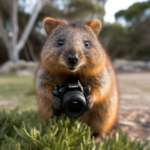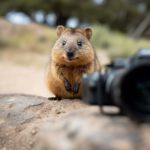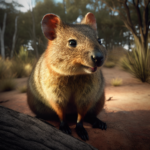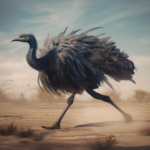Quokkas are small marsupials that are native to Western Australia. These adorable creatures are known for their friendly and curious nature, as well as their endearing smile. Despite their popularity, many people are unaware of where exactly quokkas live. In this article, we will explore the natural habitat of quokkas and the specific locations where they can be found. So, if you’ve ever wondered about the whereabouts of these delightful animals, keep reading to discover the fascinating world of quokkas.
Key Takeaways
- Quokkas are native to the southwestern part of Australia, primarily found in Western Australia.
- They inhabit a range of habitats including forests, woodlands, and coastal heathlands.
- Rottnest Island, located off the coast of Western Australia, is known for its large quokka population and is a popular tourist destination to see these unique creatures.
- Quokkas are known for their friendly and curious nature, often approaching humans without fear.
- Conservation efforts are crucial to protect the quokka population and their habitats from threats such as habitat loss and introduced predators.
Understanding the Quokka: A Brief Overview
A. What is a Quokka?
The quokka, scientifically known as Setonix brachyurus, is a small marsupial that is native to Western Australia. It belongs to the same family as kangaroos and wallabies, making it a distant relative of these iconic Australian animals. Quokkas are often referred to as the “happiest animal on Earth” due to their friendly and seemingly smiling facial expressions.
Quokkas are small wallabies, measuring about 40 to 54 centimeters (16 to 21 inches) in length and weighing around 2.5 to 5 kilograms (5.5 to 11 pounds). They have a stocky build, with short legs and a short tail. Their fur is coarse and sandy brown in color, helping them blend in with their natural environment.
B. Lifespan of a Quokka
Quokkas have a relatively short lifespan compared to some other marsupials. In the wild, they typically live for about 10 years. However, in captivity, where they are protected from predators and have access to a consistent food supply, they can live up to 15 years.
The quokka population is primarily concentrated on two islands off the coast of Western Australia: Rottnest Island and Bald Island. Rottnest Island, located about 18 kilometers (11 miles) west of Perth, is the most well-known habitat for quokkas. It is estimated that there are around 12,000 to 14,000 quokkas on Rottnest Island alone.
Quokkas are also found on Bald Island, which is situated near Albany in Western Australia. However, the population on Bald Island is much smaller, with only a few hundred individuals. These islands provide a suitable environment for quokkas, with a mix of open grasslands, shrubs, and woodlands.
Quokka Distribution and Behavior
Quokkas are primarily nocturnal animals, meaning they are most active during the night. They spend their days resting in shady areas and emerge in the evening to search for food. Quokkas are herbivores, feeding on a variety of plants, grasses, and leaves. They have specialized teeth that allow them to efficiently chew their food.
In terms of behavior, quokkas are generally social animals. They live in small family groups, known as mobs, consisting of a dominant male, several females, and their offspring. These mobs have overlapping home ranges, but each individual has its own territory within the group.
Quokkas are known for their adaptability and resilience. They have evolved to survive in a harsh environment, where food and water can be scarce. They are also excellent swimmers, which allows them to move between different parts of their island habitats.
Quokka Conservation and Threats
Despite their seemingly carefree and happy demeanor, quokkas face several conservation challenges. Their limited distribution and vulnerability to habitat loss make them a species of concern. Efforts are being made to protect their habitats and ensure their long-term survival.
Quokkas are protected by law in Western Australia, and it is illegal to harm or harass them. However, they still face threats from introduced predators, such as foxes and feral cats, which can prey on quokkas and their young. Habitat destruction due to urbanization and tourism development also poses a risk to their population.
Conservation organizations and government agencies are working together to implement measures to protect quokkas and their habitats. These include predator control programs, habitat restoration initiatives, and public education campaigns to raise awareness about the importance of conserving these unique marsupials.
In conclusion, the quokka is a fascinating marsupial that is endemic to Western Australia. Its unique appearance and friendly demeanor have made it a beloved symbol of Australian fauna. While they primarily inhabit Rottnest Island and Bald Island, efforts are being made to ensure their survival and protect their natural habitats. By raising awareness and taking conservation actions, we can help secure the future of these adorable and iconic creatures.
The Habitat of Quokkas: An In-depth Analysis

A. What is the Habitat of a Quokka?
Quokkas, small wallabies native to Western Australia, are known for their unique habitat and behavior. These adorable marsupials primarily inhabit the southwestern part of the country, particularly on the mainland and a few nearby islands. They are most commonly found on Rottnest Island, which is famous for its large quokka population. However, quokkas can also be spotted on other islands such as Bald Island and in some parts of the mainland.
B. The Biome Quokkas Inhabit
Quokkas are well-adapted to their natural environment, which is characterized by a Mediterranean climate. This type of climate is typically found in the southwestern region of Western Australia. The Mediterranean biome is known for its mild, wet winters and hot, dry summers. The vegetation in this area consists of shrubs, grasses, and low-lying plants that provide ample food and shelter for quokkas.
C. Specifics of Quokka Habitats in Western Australia
-
Rottnest Island: Rottnest Island is undoubtedly the most famous habitat for quokkas. Located just off the coast of Perth, this island is home to a significant population of these adorable marsupials. The island’s diverse vegetation, including coastal heathlands and woodlands, provides an ideal habitat for quokkas. The absence of natural predators on the island has allowed the quokka population to thrive.
-
Bald Island: Another notable habitat for quokkas is Bald Island, located in the Recherche Archipelago. This small island is home to a smaller population of quokkas compared to Rottnest Island. The vegetation on Bald Island is characterized by low-lying shrubs and grasses, creating a suitable environment for these marsupials.
-
Mainland Western Australia: Quokkas can also be found in some parts of the mainland, particularly in the southwestern region. Here, they inhabit a variety of habitats, including forests, woodlands, and coastal areas. The availability of food sources such as grasses, leaves, and fruits contributes to their survival in these diverse environments.
It is important to note that quokkas are primarily nocturnal animals, meaning they are most active during the night. They spend their days resting in shaded areas to avoid the heat and conserve energy. Quokkas are also known for their ability to adapt to different environments, which has allowed them to survive in various habitats across Western Australia.
In conclusion, quokkas are fascinating creatures that have adapted to thrive in the unique habitats of Western Australia. From the famous Rottnest Island to the mainland forests and woodlands, these small wallabies have found a way to survive and flourish. Their ability to adapt, coupled with the absence of natural predators in certain areas, has contributed to the growth of the quokka population. As we continue to learn more about these adorable marsupials, it is crucial to ensure their conservation and protect their habitats for future generations to enjoy.
Geographical Distribution of Quokkas: A Global Perspective
A. Where Do Quokkas Live in the World?
Quokkas, small wallabies known for their friendly and photogenic nature, are native to Western Australia. They have a limited geographical distribution and are primarily found in the southwestern part of the continent. Quokkas inhabit a few specific locations, with their main residence being in Australia.
B. Quokkas in Australia: Their Primary Residence
Within Australia, the primary habitat of quokkas is the stunning Rottnest Island, located just off the coast of Perth in Western Australia. This island is home to a significant population of quokkas, estimated to be around 12,000 individuals. The unique environment of Rottnest Island provides the perfect conditions for these marsupials to thrive.
C. The Significance of Rottnest Island for Quokkas
Rottnest Island plays a crucial role in the conservation of quokkas. The absence of natural predators on the island has allowed the quokka population to flourish. Additionally, the island’s diverse vegetation, including grasslands, shrubs, and woodlands, provides an abundant food source for these herbivorous creatures.
The island’s isolation has also contributed to the preservation of quokkas. With limited human interference, the quokkas on Rottnest Island have developed a unique and trusting relationship with humans, making them one of the few wild animals that are comfortable being approached by people.
D. Where Else Do Quokkas Live?
While Rottnest Island is the primary home of quokkas, they can also be found on a few other islands off the coast of Western Australia. One such island is Bald Island, located near Albany. Although the population of quokkas on Bald Island is smaller compared to Rottnest Island, it is still an important habitat for these adorable marsupials.
It’s worth noting that quokkas are not found on the Australian mainland. Their distribution is limited to specific islands in Western Australia, making them a unique and iconic part of the Australian fauna.
In conclusion, quokkas have a restricted geographical distribution, with their primary residence being Rottnest Island in Western Australia. The island’s unique environment and absence of natural predators have allowed the quokka population to thrive. While they can also be found on other islands, such as Bald Island, their presence on the Australian mainland is nonexistent. The conservation efforts on Rottnest Island and other habitats are crucial for ensuring the long-term survival of these charismatic marsupials.
The Quokka Map: Visualizing Their Global Presence

A. Understanding the Quokka Map
The quokka, a small marsupial native to Western Australia, has captured the hearts of people around the world with its adorable appearance and friendly demeanor. To better understand where these delightful creatures live, researchers have created a quokka map that visualizes their global presence.
The quokka map provides valuable insights into the distribution and habitat preferences of these unique animals. By studying their range, scientists can gain a deeper understanding of their behavior, adaptation, and lifestyle. Let’s explore the quokka map and uncover the fascinating details it reveals.
B. The Spread of Quokkas in Western Australia
Quokkas are primarily found in Western Australia, where they inhabit a variety of habitats ranging from coastal heathlands to forests. They are most abundant on Rottnest Island, located just off the coast of Perth, and Bald Island, which lies in the Recherche Archipelago.
On the mainland, quokkas can be spotted in several locations, including the Cape Range National Park, Fitzgerald River National Park, and the Two Peoples Bay Nature Reserve. These areas provide the perfect environment for quokkas to thrive, with an abundance of food sources and suitable shelter.
C. Quokka Distribution on Rottnest Island
Rottnest Island is undoubtedly the quokka capital of the world, with a thriving population of these endearing creatures. The island’s unique ecosystem, characterized by sandy soils, coastal vegetation, and freshwater lakes, provides an ideal habitat for quokkas.
Quokkas on Rottnest Island are known for their relaxed and friendly nature, often approaching visitors in search of food. They have become an iconic symbol of the island, attracting tourists from far and wide who hope to capture a selfie with these adorable marsupials.
The quokka population on Rottnest Island is carefully managed to ensure their conservation and protection. Efforts are made to educate visitors about responsible interaction with the quokkas, emphasizing the importance of not feeding them human food and maintaining a respectful distance.
In conclusion, the quokka map offers valuable insights into the global presence of these charming marsupials. While they are primarily found in Western Australia, their stronghold lies on Rottnest Island, where they have become an integral part of the island’s identity. By understanding their distribution and habitat preferences, we can work towards ensuring the long-term survival of these unique and lovable creatures.
The Life of Baby Quokkas: A Closer Look

A. Where Do Baby Quokkas Live?
Baby quokkas, also known as joeys, are fascinating creatures that inhabit the unique and diverse landscapes of Western Australia. These adorable marsupials can be found primarily on Rottnest Island, located just off the coast of Perth, as well as on Bald Island and a few other smaller islands in the region.
Rottnest Island, in particular, is renowned for its large quokka population, making it a popular tourist destination for those wanting to catch a glimpse of these charismatic animals. The island’s favorable climate and abundant vegetation provide an ideal habitat for quokkas to thrive.
Quokkas are well-adapted to their environment and have developed certain behaviors and characteristics that help them survive in their natural habitat. They are primarily nocturnal animals, which means they are most active during the night. This behavior allows them to avoid the scorching heat of the day and reduces their exposure to potential predators.
These small wallabies are herbivores, feeding on a variety of plants, grasses, and leaves found on the islands. Their diet consists mainly of vegetation, but they have also been known to eat fruits and seeds when available. Quokkas have a unique ability to extract water from their food, which helps them survive in the arid conditions of their habitat.
B. The Survival and Growth of Baby Quokkas
The survival and growth of baby quokkas are crucial for the long-term sustainability of their population. Female quokkas typically give birth to one joey at a time, which spends the first few months of its life inside its mother‘s pouch. This pouch provides a safe and nurturing environment for the joey to develop and grow.
After around six months, the joey starts to venture out of the pouch and explore its surroundings. However, it continues to rely on its mother for nourishment and protection. The bond between a mother quokka and her joey is strong, and she will often carry it on her back as it becomes more independent.
As the joey grows older, it gradually becomes more self-sufficient and starts to feed on solid food. At around one year of age, the joey becomes fully independent and separates from its mother. It then establishes its own territory within the quokka population.
The growth and survival of baby quokkas are influenced by various factors, including the availability of food, water, and suitable shelter. Conservation efforts are crucial to ensure the preservation of their natural habitat and protect them from potential threats, such as habitat loss and introduced predators.
In conclusion, baby quokkas live in the unique and diverse landscapes of Western Australia, primarily on Rottnest Island. They are well-adapted to their environment and exhibit behaviors that help them survive and thrive. The survival and growth of baby quokkas are essential for the long-term sustainability of their population, making conservation efforts vital to their well-being. Conclusion
In conclusion, quokkas are fascinating creatures that inhabit the southwestern region of Australia. These small marsupials are primarily found on Rottnest Island, where they have become an iconic symbol of the island’s unique wildlife. Quokkas are also found on the mainland, particularly in the forests and coastal areas of Western Australia. Their ability to adapt to different habitats and their friendly and curious nature make them a delight to encounter. However, it is important to remember that quokkas are wild animals and should be observed from a respectful distance. Conservation efforts are crucial to ensure the survival of these adorable creatures and to protect their natural habitats. So, if you ever find yourself in the beautiful land down under, be sure to visit Rottnest Island or explore the forests of Western Australia for a chance to catch a glimpse of these adorable and photogenic quokkas in their natural habitat.
Frequently Asked Questions
Where do quokkas live in the world?
Quokkas are native to Australia and are primarily found in small islands off the coast of Western Australia. The largest population resides on Rottnest Island, with a smaller population on Bald Island. They can also be found in scattered populations along the mainland’s southwest coast.
What is the habitat of a quokka?
Quokkas are marsupials that prefer a warm climate and live in a variety of habitats including forests, shrublands, and semi-arid regions. They are well-adapted to their environment on Rottnest Island, which is a mix of scrub and woodland.
How long can a quokka live?
On average, quokkas live for about 10 years in the wild. Their lifespan can be influenced by factors such as predation, disease, and availability of food and water.
Where do baby quokkas live?
Baby quokkas, known as joeys, live in their mother‘s pouch for the first six months of their life. After leaving the pouch, joeys continue to stay close to their mother for another two months before becoming fully independent.
What biome does a quokka live in?
Quokkas live in the temperate forest biome, specifically in areas with dense vegetation and undergrowth. This provides them with shelter from predators and harsh weather, and also gives them access to their food sources.
Where else do quokkas live apart from Rottnest Island?
Apart from Rottnest Island, quokkas also live on Bald Island and in several scattered populations along the coast of Western Australia. However, these populations are smaller and more vulnerable than the Rottnest Island population.
What is the quokka population in Australia?
The quokka population is estimated to be around 10,000-12,000, with the majority living on Rottnest Island. The population on the mainland is smaller and more at risk due to predation and habitat loss.
What are the main threats to quokka conservation?
The main threats to quokka conservation include habitat loss due to urban development, predation by introduced species like foxes and cats, and climate change which can lead to changes in their habitat and food sources.
What is the diet of a quokka?
Quokkas are herbivores and their diet mainly consists of leaves, stems, and bark of several plant species. They can also eat grasses and shrubs. Quokkas have a unique ability to survive without water for long periods, getting most of their hydration from their food.
How does quokka behavior adapt to their environment?
Quokkas are nocturnal and crepuscular, meaning they are most active during the night and at dawn and dusk. This behavior helps them avoid the heat of the day. They are also excellent climbers, which helps them reach food and escape predators. Despite their small size, quokkas are known to be quite resilient and have adapted well to their environment.




